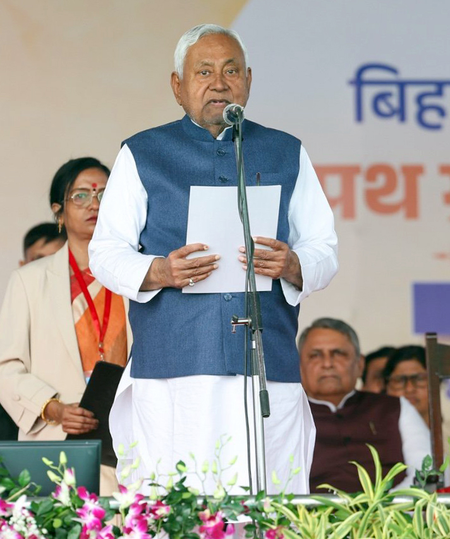
Patna, Nov 20 (IANS) “I, Nitish Kumar…” At 11:35 a.m. on Thursday, November 20, the naysayers silently watched him take the oath of office and secrecy for the 10th time as the Chief Minister of Bihar. Till then, there was a chorus of doubts that the Bharatiya Janata Party (BJP) would not allow the 74-year-old leader of the Janata Dal (U) to lead the National Democratic Alliance (NDA) state government “this time”.
A similar doubt was sown in 2020 before Nitish Kumar swore in as the head of the state government, with a mask underscoring the first such democratic process held in India in the aftermath of the Covid pandemic. However, whether the JD (U) got 43 seats (in the 2020 Assembly election) or 85 (in 2025), whether the ally returned to the Bihar Legislative Assembly as the single third – or the second-largest party, the BJP abided by its pledge of a government led by Nitish Kumar.
Through his long political career, the JD(U) leader has been associated with many different parties. Born on March 1, 1951, in Bakhtiarpur, Nitish Kumar emerged from the socialist tradition and entered electoral politics in the 1970s before rising through organisational roles in Janata Parivar formations and later the Janata Dal (United).
His first significant executive breakthrough came in 2000 with a short stint as Chief Minister, then representing the Samata Party. He returned in 2005 and formed a stable government that marked the start of his public image as a leader focused on governance and law-and-order reform.
Over the next two decades, Nitish combined electoral appeal with frequent alliance recalibrations, alternating between partnerships with the BJP and opposition coalitions as political circumstances required. He has served multiple terms as the Chief Minister — building a reputation for administrative interventions in infrastructure, rural electrification, road construction and public distribution reforms, earning the sobriquet of “sushashanbabu” or Mr Good Governance.
His approach mixed technocratic initiatives with caste-sensitive political engineering, which helped sustain a broad, if sometimes shifting, support base. His colleague-turned-adversary Prashant Kishor had once famously stated in Hindi, loosely translated as Bihar blooms under Nitish Kumar.
Journalist Sankarshan Thakur had aptly titled Nitish Kumar’s biography ‘Single Man’, calling him “a wary man, often too careful, he won’t step onto ground he isn’t certain will hold”. The book mentions that in 1992, Nitish Kumar was not even on talking terms with Lalu Prasad and had an extremely ugly spat.
On the other hand, he firmly opposed Narendra Modi as PM in 2014. However, he allied with both at different times, switching sides midway, even while heading the state government. But the veteran politician has this habit of speaking out even at the cost of being politically incorrect, which, when pointed out, would bring out his reaction as “following my conscience”.
In recent times, the septuagenarian was reportedly facing persistent administrative challenges in sectors like health, education, and employment. Nitish Kumar already enjoys the distinction of cumulatively being the longest serving premier of the state, and now, after serving a full five-year term, he would be among India’s top-three longest serving Chief Ministers.
India’s federal politics offer both precedents for long-serving chief ministers and contrasts in style, where leaders like Pawan Kumar Chamling of Sikkim and Naveen Patnaik of Odisha hold the distinction of being in office for over 24 years continuously. As did Jyoti Basu of West Bengal, who stepped down after serving for more than 23 years and four months.
Nitish Kumar has already served a cumulative term of over 19 years and eight months, and counting.
–IANS
jb/skp
